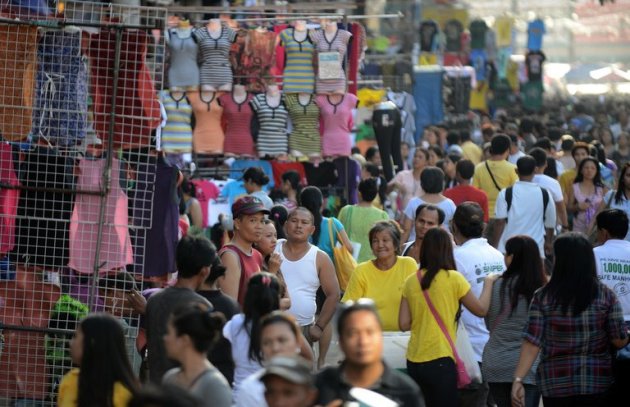
In Nielsen’s fourth-quarter 2012 Consumer Confidence Index, consumer confidence in the Philippines was at 119 in the fourth quarter of last year, just below India’s 121. An index of more than 101 indicates optimism while an index of 100 indicates pessimism.
Filipino consumers’ optimism rose by a point from 118 in the third quarter of last year.
“While consumers around the world struggled with increasing economic concerns, consumers in Philippines continue to have a positive outlook. This optimism can be attributed to the strong performance of the economy in 2012 which was driven by the real estate, construction, manufacturing, services, and trade sectors,” Nielsen Philippines managing director Stuart Jamieson said.
Latest National Statistical Coordination Board (NSCB) data showed that household consumption rose 6.9 percent for the whole of 2012, bolstering consumer spending that helped lift the country’s gross domestic product (GDP) to 6.6 percent, exceeding government targets.
Amid an improving domestic economy, more Filipinos are looking forward to landing better jobs, with 76 percent of respondents—4 percent more than in the third quarter—claiming “employment opportunities would be good or excellent in the next 12 months.”
“Filipino respondents’ optimism for local job prospects is also among the world’s highest,” Nielsen said.
Still, job security remains the Filipinos’ foremost concern, followed by work-life balance, health, the economy, parent’s welfare/happiness, and increasing utility bills, Nielsen said.
Also, half of the Filipino respondents said they experienced a “recession” in the fourth quarter, less than the 56 percent during the previous quarter and 59 percent in the fourth quarter of 2011.
Given a still fragile global economic outlook, Filipino consumers are saving up, with 65 percent putting spare cash into savings during the fourth quarter, although 2 percent more said they were saving money during the third quarter.
Confidence in personal finances was at 77 percent, one-percent lower than the previous quarter.
Given the booming stock and other financial markets, 21 percent said they have invested in shares of stock/mutual funds, up two percent from the third quarter.
With most Filipino receiving their bonuses in the fourth quarter, 51 percent of the Filipino consumers polled then said it was a “good time” to purchase the things they need and want over the next 12 months. “This is an increase of five points from the previous quarter’s result and the highest confidence registered for 2012,” Nielsen said.
And what did most Filipinos buy or allocate their money for towards the end of last year? According to Nielsen, purchase of new technology products rose one percent to 35 percent; purchase of new clothes increased by 2 percent to 34 percent; paying off credit cards and debt declined 1 percent to 27 percent; spending intentions for holidays and vacations went up 1 percent to 28 percent; and out-of-home entertainment grew 5 percent to 18 percent.
Among the 58 countries covered by the report, eight of the 10 countries with most confident consumers were in Asia: India, the Philippines, Indonesia (with an index of 117), Thailand (115), United Arab Emirates (113), Saudi Arabia (112), China (108) and Malaysia (103).
Brazil (with an index of 111) and Norway (102) rounded up the top 10 countries with most optimistic consumers.
The Philippines “joins other high population markets with robust economies such as India, Indonesia, Thailand and China out of global recession and in their optimism about the future,” Nielsen said.
Consumers in the Philippines join their Asia-Pacific peers as among the more prolific savers. “Asia-Pacific consumers are at least two times more likely to have spare cash than any other region in the world. Majority (58 percent) report that any spare cash is funneled into savings,” Nielsen said.
Consumers in Asia-Pacific are also more “cautious spenders.” “To save on household spending, Asia-Pacific consumers cut back on new clothes, out-of-home entertainment, and switched to cheaper grocery brands,” Nielsen said.
The country with the least optimistic consumers is crisis-hit Greece, whose consumer confident index is at 35. Seven others among the 10 least optimistic countries are in Europe: Hungary, Portugal, Italy, Croatia, Spain, France and Slovakia—reflecting declining consumer confidence spread throughout Europe amid the debt problems of most economies in the continent.
South Korea and Japan also have among the least confident consumers, with index scores of 38 and 59, respectively. Nielsen noted that these two Asian economic giants are export-dependent, hence “more exposed to precarious global conditions.”
On the whole, global consumer confidence during the fourth quarter of last year indexed at 91, one point lower than in the third quarter but two points more than the fourth quarter of 2011.
Of the 58 countries measured by Nielsen, confidence went down in 33 countries, was flat in six countries, and rose in 19 countries, when compared with the previous quarter.
“Consumers around the world grappled with increasing economic concerns as the Euro zone crisis spread from troubled to core countries, the United States fiscal cliff threat loomed large, and China’s rising inflation sparked monetary policy action,” said Dr. Venkatesh Bala, chief economist at The Cambridge Group, a part of Nielsen.
Following last year’s economic difficulties, “consumers are proceeding with caution in 2013 and showed renewed discretionary spending restraint in the last quarter amid further global economic and political uncertainty,” Bala said.
In Asia-Pacific, recession sentiments have improved, Nielsen said.
The Nielsen Global Survey of Consumer Confidence and Spending Intentions was established in 2005 to measure consumer confidence, major concerns and spending intentions among over 29,000 respondents with Internet access in 58 countries.
The latest round of the survey was conducted between November 10 and November 27, 2012.-Interaksyon (February 05, 2013 3:55PM)

No comments:
Post a Comment